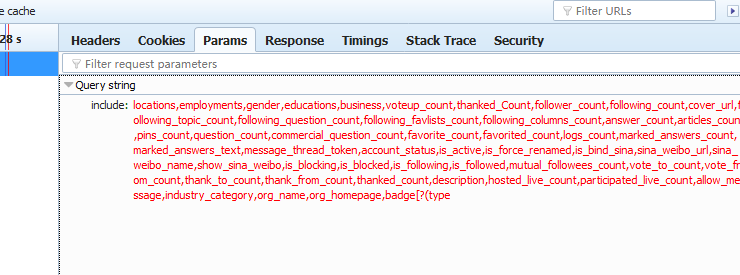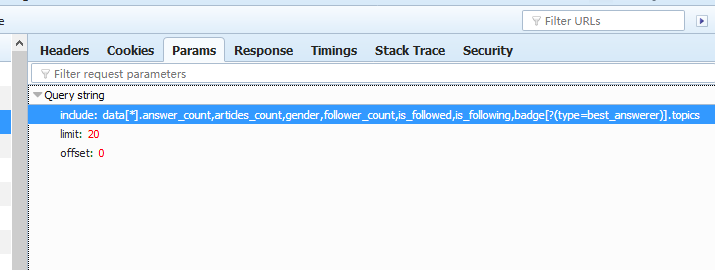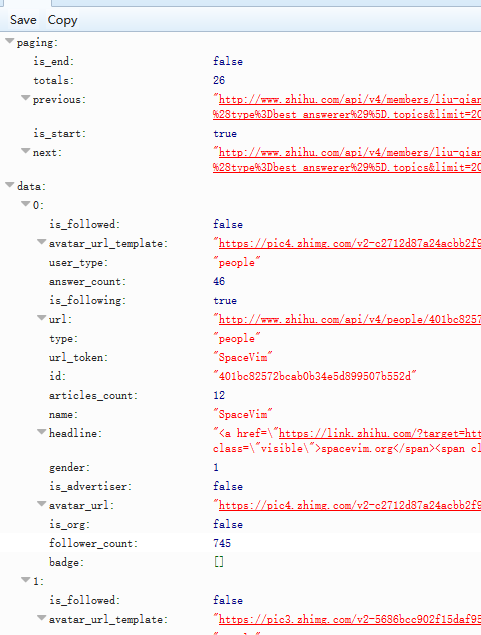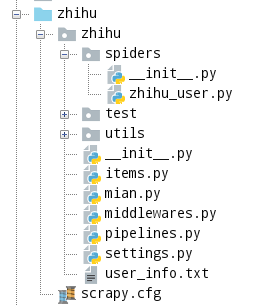上一次爬取了知乎问题和答案,这一次来爬取知乎用户的信息
一 构造url
首先构造用户信息的url
知乎用户信息都是放在一个json文件中,我们找到存放这个json文件的url,就可以请求这个json文件,得到我们的数据.
url="https://www.zhihu.com/api/v4/members/liu-qian-chi-24?include=locations,employments,gender,educations,business,voteup_count,thanked_Count,follower_count,following_count,cover_url,following_topic_count,following_question_count,following_favlists_count,following_columns_count,answer_count,articles_count,pins_count,question_count,commercial_question_count,favorite_count,favorited_count,logs_count,marked_answers_count,marked_answers_text,message_thread_token,account_status,is_active,is_force_renamed,is_bind_sina,sina_weibo_url,sina_weibo_name,show_sina_weibo,is_blocking,is_blocked,is_following,is_followed,mutual_followees_count,vote_to_count,vote_from_count,thank_to_count,thank_from_count,thanked_count,description,hosted_live_count,participated_live_count,allow_message,industry_category,org_name,org_homepage,badge[?(type=best_answerer)].topics",
这是我的知乎的url,前面加颜色的部分是用户名,后面一部分你要请求的内容,这个内容当然不是我手写的,是浏览在请求时对应的参数.

可以看到,这就是请求用户信息时,include后面所包含的内容,由些,用户信息的url构成为
user_url = 'https://www.zhihu.com/api/v4/members/{user}?include={include}'
include参数如下:
user_query = 'locations,employments,gender,educations,business,voteup_count,thanked_Count,follower_count,following_count,cover_url,following_topic_count,following_question_count,following_favlists_count,following_columns_count,answer_count,articles_count,pins_count,question_count,commercial_question_count,favorite_count,favorited_count,logs_count,marked_answers_count,marked_answers_text,message_thread_token,account_status,is_active,is_force_renamed,is_bind_sina,sina_weibo_url,sina_weibo_name,show_sina_weibo,is_blocking,is_blocked,is_following,is_followed,mutual_followees_count,vote_to_count,vote_from_count,thank_to_count,thank_from_count,thanked_count,description,hosted_live_count,participated_live_count,allow_message,industry_category,org_name,org_homepage,badge[?(type=best_answerer)].topics'
接下来 构造关注我的人 的url:
可以通过浏览器看到 关注我的人 的url是 https://www.zhihu.com/api/v4/members/liu-qian-chi-24/followees?include=data%5B%2A%5D.
answer_count%2Carticles_count%2Cgender%2Cfollower_count%2Cis_followed%2Cis_following%2Cbadge%5B%3F%28type%3Dbest
_answerer%29%5D.topics&limit=20&offset=0
我们要构造这四部分,可以看到初次请时的参数:
这里有三个参数了 liu-qian-chi-24 是用户名,加上用户名后就可以构成了关注他的人 信息的url,了,构成如下
followed_url = "https://www.zhihu.com/api/v4/members/{user}/followers?include={include}&limit={limit}&offset={offset}"
include参数如下:
followed_query = "data[*].answer_count,articles_count,gender,follower_count,is_followed,is_following,badge[?(type=best_answerer)].topics"
接下来 构造我关注的人的url:
以同样的方法可以构造 我关注的人 的信息url. 浏览器中参数如下:

由此把我关注的人的url 构造出来:
following_url = "https://www.zhihu.com/api/v4/members/{user}/followees?include={include}&limit={limit}&offset={offset}"
include参数如下:
following_query = "data[*].answer_count,articles_count,gender,follower_count,is_followed,is_following,badge[?(type=best_answerer)].topics"
二 模拟知乎登录
因为知乎在没有登录情况下是不能访问的,所以一定要模拟登录,登录过程中会出现输入验证码的情况 ,我没有使用云打码的方式,这次我把验证码下载到本地,通过手工输入,
代码如下:
def start_requests(self): """请求登录页面""" return [scrapy.Request(url="https://www.zhihu.com/signup", callback=self.get_captcha)] def get_captcha(self, response): """这一步主要是获取验证码""" post_data = { "email": "lq574343028@126.com", "password": "lq534293223", "captcha": "", # 先把验证码设为空,这样知乎就会提示输入验证码 } t = str(int(time.time() * 1000)) # 这里是关键,这也是我找了好久才找到的方法,这就是知乎每次的验证码图片的url captcha_url = "https://www.zhihu.com/captcha.gif?r={0}&type=login".format(t) return [scrapy.FormRequest(url=captcha_url, meta={"post_data": post_data}, callback=self.after_get_captcha)] def after_get_captcha(self, response): """把验证码存放到本地,手工输入""" with open("E:/outback/zhihu/zhihu/utils/captcha.png", "wb") as f: f.write(response.body) try: # 这一句就是让程序自动打打图片 img = Image.open("E:/outback/zhihu/zhihu/utils/captcha.png") img.show() except: pass captcha = input("input captcha") post_data = response.meta.get("post_data", {}) post_data["captcha"] = captcha post_url = "https://www.zhihu.com/login/email" return [scrapy.FormRequest(url=post_url, formdata=post_data, callback=self.check_login)] def check_login(self, response): """验证是否登录成功""" text_json = json.loads(response.text) if "msg" in text_json and text_json["msg"] == "登录成功": yield scrapy.Request("https://www.zhihu.com/", dont_filter=True, callback=self.start_get_info) else: # 如果不成功就再登录一次 return [scrapy.Request(url="https://www.zhihu.com/signup", callback=self.get_captcha)] def start_get_info(self, response): """登录成功后就可以去请求用户信息""" yield scrapy.Request(url=self.user_url.format(user="liu-qian-chi-24", include=self.user_query), callback=self.parse_user)
三 处理处理请求用户信息url所得到的response
可以看到用户信息就是一个json文件,我们解析这个json文件就行:

只是一点要注意 : is_end 意思是 是否还有下一页,注意 这里不能用 next 是否能打开来判断,因为无论怎么样都能打开,
user_token 就是网页中的用户名,我们用这个用户名加上其他参数来构造关注他,和他关注的url 信息.代码如下:
def parse_user(self, response): user_data = json.loads(response.text) zhihu_item = ZhihuUserItem() # 解析这个json文件,如果这个key在item中,就存出item,这里用字典的get()方法,即使字典中没有这个值也不会出错 for field in zhihu_item.fields: if field in user_data.keys(): zhihu_item[field] = user_data.get(field) yield zhihu_item # 通过url_token信息把followed_url yield出去 yield scrapy.Request( url=self.followed_url.format(user=user_data.get('url_token'), include=self.followed_query, limit=20,offset=0, ), callback=self.parse_followed) # 通过url_token信息把following_url yield出去 yield scrapy.Request( url=self.following_url.format(user=user_data.get('url_token'), include=self.following_query,limit=20, offset=0, ), callback=self.parse_following)
四 分别解析following_url 和 followed_url
接下来就是分别解析following_url 和 followed_url 解析方法和解析user_url一下,这里就不详细说明了,代码如下:
def parse_following(self, response): user_data = json.loads(response.text) zhihu_item = ZhihuUserItem() # 请求下一个页面 if "paging" in user_data.keys() and user_data.get("paging").get("next") == "false": next_url = user_data.get("paging").get("next") yield scrapy.Request(url=next_url, callback=self.parse_following) if "data" in user_data.keys(): for result in user_data.get("data"): url_token = result.get("url_token") yield scrapy.Request(url=self.user_url.format(user=url_token, include=self.user_query), callback=self.parse_user) def parse_followed(self, response): user_data = json.loads(response.text) zhihu_item = ZhihuUserItem() # 请求下一个页面 if "paging" in user_data.keys() and user_data.get("paging").get("next") == "false": next_url = user_data.get("paging").get("next") yield scrapy.Request(url=next_url, callback=self.parse_followed) if "data" in user_data.keys(): for result in user_data.get("data"): url_token = result.get("url_token") yield scrapy.Request(url=self.user_url.format(user=url_token, include=self.user_query), callback=self.parse_user)
至些 spider 中主要的逻辑结束.接下来我们来把数据存入到mongodb 中
五 pipleline 存入mongodb
class ZhihuUserMongoPipeline(object): collection_name = 'scrapy_items' def __init__(self, mongo_uri, mongo_db): self.mongo_uri = mongo_uri self.mongo_db = mongo_db @classmethod def from_crawler(cls, crawler): return cls( mongo_uri=crawler.settings.get('MONGO_URI'), mongo_db=crawler.settings.get('MONGO_DATABASE', 'items') ) def open_spider(self, spider): self.client = pymongo.MongoClient(self.mongo_uri) self.db = self.client[self.mongo_db] def close_spider(self, spider): self.client.close() def process_item(self, item, spider): # self.db[self.collection_name].insert_one(dict(item)) # 为了使用数据不重复,我们这里以ID为准进行更新 self.db[self.collection_name].update({'id': item['id']}, dict(item), True) return item
六 配置好settings
ROBOTSTXT_OBEY = False DOWNLOAD_DELAY = 3 DEFAULT_REQUEST_HEADERS = { 'Accept': 'text/html,application/xhtml+xml,application/xml;q=0.9,*/*;q=0.8', 'Accept-Language': 'en', "HOST": "www.zhihu.com", "Referer": "https://www.zhizhu.com", "User-Agent": "Mozilla/5.0 (Windows NT 10.0; Win64; x64; rv:58.0) Gecko/20100101 Firefox/58.0", } ITEM_PIPELINES = { # 'zhihu.pipelines.ZhihuPipeline': 300, 'zhihu.pipelines.ZhihuUserMongoPipeline': 300, } MONGO_URI="127.0.0.1:27017" MONGO_DATABASE="outback"
七 编写item
编写item非常简单,因为我这次是把数据存入mongodb中,所以我尽量多抓取数据,我们在请求那三个url时,每个url都有一个include, 这个就是知乎的所有字段,我们去重就行
following_query = "data[*].answer_count,articles_count,gender,follower_count,is_followed,is_following,badge[?(type=best_answerer)].topics" followed_query = "data[*].answer_count,articles_count,gender,follower_count,is_followed,is_following,badge[?(type=best_answerer)].topics" user_query = 'locations,employments,gender,educations,business,voteup_count,thanked_Count,follower_count,following_count,cover_url,following_topic_count,following_question_count,following_favlists_count,following_columns_count,answer_count,articles_count,pins_count,question_count,commercial_question_count,favorite_count,favorited_count,logs_count,marked_answers_count,marked_answers_text,message_thread_token,account_status,is_active,is_force_renamed,is_bind_sina,sina_weibo_url,sina_weibo_name,show_sina_weibo,is_blocking,is_blocked,is_following,is_followed,mutual_followees_count,vote_to_count,vote_from_count,thank_to_count,thank_from_count,thanked_count,description,hosted_live_count,participated_live_count,allow_message,industry_category,org_name,org_homepage,badge[?(type=best_answerer)].topics'
item 代码如下:

class ZhihuUserItem(scrapy.Item): # url info item 这几个字段构成了url answer_count = scrapy.Field() articles_count = scrapy.Field() gender = scrapy.Field() follower_count = scrapy.Field() is_followed = scrapy.Field() is_following = scrapy.Field() badge = scrapy.Field() id = scrapy.Field() # 其他我们需要的信息 locations = scrapy.Field() employments = scrapy.Field() educations = scrapy.Field() business = scrapy.Field() voteup_count = scrapy.Field() thanked_Count = scrapy.Field() following_count = scrapy.Field() cover_url = scrapy.Field() following_topic_count = scrapy.Field() following_question_count = scrapy.Field() following_favlists_count = scrapy.Field() following_columns_count = scrapy.Field() pins_count = scrapy.Field() question_count = scrapy.Field() commercial_question_count= scrapy.Field() favorite_count = scrapy.Field() favorited_count = scrapy.Field() logs_count = scrapy.Field() marked_answers_count = scrapy.Field() marked_answers_text = scrapy.Field() message_thread_token = scrapy.Field() account_status = scrapy.Field() is_active = scrapy.Field() is_force_renamed = scrapy.Field() is_bind_sina = scrapy.Field() sina_weibo_urlsina_weibo_name = scrapy.Field() show_sina_weibo = scrapy.Field() is_blocking = scrapy.Field() is_blocked = scrapy.Field() mutual_followees_count = scrapy.Field() vote_to_count = scrapy.Field() vote_from_count = scrapy.Field() thank_to_count = scrapy.Field() thank_from_count = scrapy.Field() thanked_count = scrapy.Field() description = scrapy.Field() hosted_live_count = scrapy.Field() participated_live_count = scrapy.Field() allow_message = scrapy.Field() industry_category = scrapy.Field() org_name = scrapy.Field() org_homepage = scrapy.Field()
八 mian()函数
当然,为了边写边调试,我们还少不了一个mian()函数,这样方便打断点调试
from scrapy.cmdline import execute import sys import os sys.path.insert(0,os.path.dirname(os.path.abspath(__file__))) print(os.path.dirname(os.path.abspath(__file__))) execute(["scrapy", "crawl", "zhihu_user"])
到此项目完成,照例把完整的spider代码写在这里:

# -*- coding: utf-8 -*- import scrapy import time from PIL import Image import json from zhihu.items import ZhihuUserItem class ZhihuUserSpider(scrapy.Spider): name = 'zhihu_user' allowed_domains = ['zhihu.com'] start_urls = ["liu-qian-chi-24"] custom_settings = { "COOKIES_ENABLED": True } # 他关注的人的url following_url = "https://www.zhihu.com/api/v4/members/{user}/followees?include={include}&limit={limit}&offset={offset}" # 关注他的人的url followed_url = "https://www.zhihu.com/api/v4/members/{user}/followers?include={include}&limit={limit}&offset={offset}" # 用户信息url user_url = 'https://www.zhihu.com/api/v4/members/{user}?include={include}' # 他关注的人的url构成参数 following_query = "data[*].answer_count,articles_count,gender,follower_count,is_followed,is_following,badge[?(type=best_answerer)].topics" # 关于他的人的url构成参数 followed_query = "data[*].answer_count,articles_count,gender,follower_count,is_followed,is_following,badge[?(type=best_answerer)].topics" # 用户信息url构成参数信息 user_query = 'locations,employments,gender,educations,business,voteup_count,thanked_Count,follower_count,following_count,cover_url,following_topic_count,following_question_count,following_favlists_count,following_columns_count,answer_count,articles_count,pins_count,question_count,commercial_question_count,favorite_count,favorited_count,logs_count,marked_answers_count,marked_answers_text,message_thread_token,account_status,is_active,is_force_renamed,is_bind_sina,sina_weibo_url,sina_weibo_name,show_sina_weibo,is_blocking,is_blocked,is_following,is_followed,mutual_followees_count,vote_to_count,vote_from_count,thank_to_count,thank_from_count,thanked_count,description,hosted_live_count,participated_live_count,allow_message,industry_category,org_name,org_homepage,badge[?(type=best_answerer)].topics' def start_requests(self): """请求登录页面""" return [scrapy.Request(url="https://www.zhihu.com/signup", callback=self.get_captcha)] def get_captcha(self, response): """这一步主要是获取验证码""" post_data = { "email": "lq573320328@126.com", "password": "lq132435", "captcha": "", # 先把验证码设为空,这样知乎就会提示输入验证码 } t = str(int(time.time() * 1000)) # 这里是关键,这也是我找了好久才找到的方法,这就是知乎每次的验证码图片的url captcha_url = "https://www.zhihu.com/captcha.gif?r={0}&type=login".format(t) return [scrapy.FormRequest(url=captcha_url, meta={"post_data": post_data}, callback=self.after_get_captcha)] def after_get_captcha(self, response): """把验证码存放到本地,手工输入""" with open("E:/outback/zhihu/zhihu/utils/captcha.png", "wb") as f: f.write(response.body) try: # 这一句就是让程序自动打打图片 img = Image.open("E:/outback/zhihu/zhihu/utils/captcha.png") img.show() except: pass captcha = input("input captcha") post_data = response.meta.get("post_data", {}) post_data["captcha"] = captcha post_url = "https://www.zhihu.com/login/email" return [scrapy.FormRequest(url=post_url, formdata=post_data, callback=self.check_login)] def check_login(self, response): """验证是否登录成功""" text_json = json.loads(response.text) if "msg" in text_json and text_json["msg"] == "登录成功": yield scrapy.Request("https://www.zhihu.com/", dont_filter=True, callback=self.start_get_info) else: # 如果不成功就再登录一次 return [scrapy.Request(url="https://www.zhihu.com/signup", callback=self.get_captcha)] def start_get_info(self, response): """登录成功后就可以去请求用户信息""" yield scrapy.Request(url=self.user_url.format(user="liu-qian-chi-24", include=self.user_query), callback=self.parse_user) def parse_user(self, response): user_data = json.loads(response.text) zhihu_item = ZhihuUserItem() # 解析这个json文件,如果这个key在item中,就存出item,这里用字典的get()方法,即使字典中没有这个值也不会出错 for field in zhihu_item.fields: if field in user_data.keys(): zhihu_item[field] = user_data.get(field) yield zhihu_item # 通过url_token信息把followed_url yield出去 yield scrapy.Request( url=self.followed_url.format(user=user_data.get('url_token'), include=self.followed_query, limit=20,offset=0, ), callback=self.parse_followed) # 通过url_token信息把following_url yield出去 yield scrapy.Request( url=self.following_url.format(user=user_data.get('url_token'), include=self.following_query,limit=20, offset=0, ), callback=self.parse_following) def parse_following(self, response): user_data = json.loads(response.text) zhihu_item = ZhihuUserItem() # 请求下一个页面 if "paging" in user_data.keys() and user_data.get("paging").get("next") == "false": next_url = user_data.get("paging").get("next") yield scrapy.Request(url=next_url, callback=self.parse_following) if "data" in user_data.keys(): for result in user_data.get("data"): url_token = result.get("url_token") yield scrapy.Request(url=self.user_url.format(user=url_token, include=self.user_query), callback=self.parse_user) def parse_followed(self, response): user_data = json.loads(response.text) zhihu_item = ZhihuUserItem() # 请求下一个页面 if "paging" in user_data.keys() and user_data.get("paging").get("next") == "false": next_url = user_data.get("paging").get("next") yield scrapy.Request(url=next_url, callback=self.parse_followed) if "data" in user_data.keys(): for result in user_data.get("data"): url_token = result.get("url_token") yield scrapy.Request(url=self.user_url.format(user=url_token, include=self.user_query), callback=self.parse_user)
项目结构如下:

九 总结
项目还有一些不足的地方
1, 应该把存入mongdo的函数写在Item类中,在Pipeline 统一调用这个类的接口就行.这样如果项目中用很多个爬虫的话,就可以共用这个类,
2.不是每个user的所有字段都有值,应该在存入数据前把没有值的字段过滤了.
3.没有加异常处理机制,我在跑这个爬虫的过程中没有出现异常,所以也就没有加异常处理机制.
4,没有做成分步式.
github https://github.com/573320328/zhihu.git 记得点start哦

